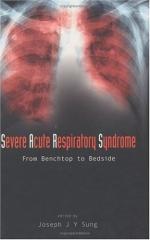|
This section contains 438 words (approx. 2 pages at 300 words per page) |

|
Severe Acute Respiratory Syndrome
Summary: This is a brief description of Severe Acute Respiratory Syndrome, also known as SARS. It includes information about its origins, symptoms, treatments and prognosis.
The corona virus was first isolated in chickens in 1937. In 1965 two men named tyrrell and bynoe used cultures of human ciliated embryonal trachea to propagate the fist human corona virus. There are now approximately 15 species in this family, which not only effect men, but pigs, cattle, rodents, cats, dogs,and birds(so basically all invertebrates). "Virions enveloped; slightly pleomorphic; spherical; (60-)120-160(-200) nm in diameter. Surface projections of envelope distinct; club-shaped (and 12-24 nm in length); spaced widely apart and dispersed evenly over all the surface. Nucleocapsids filamentous; 9 nm in diameter, or 11-13 nm in diameter. Symmetry helical. ( www.ncbi.nlm.nih.gov/ICTVdb/ICTVdB/19010000.htm#History)" Forms of the corona virus are respiratory (the most common including SARS), Enteric infections(occasional- found mostly in infants under 12months), neurological(rare). They are most commonly transmitted by someone sneezing, coughing, or regurgitation. The most common symptoms of the...
|
This section contains 438 words (approx. 2 pages at 300 words per page) |

|


